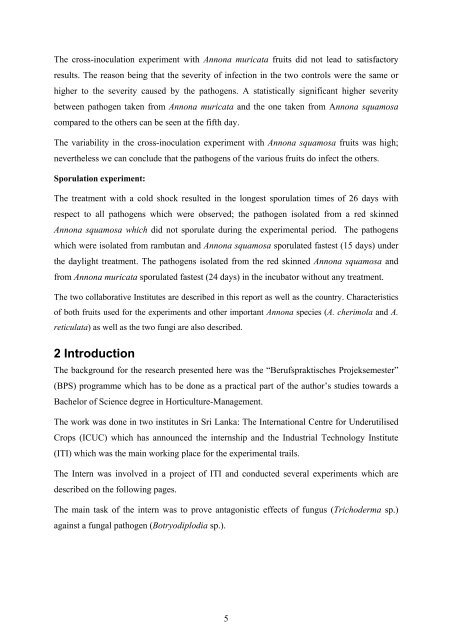Botryodiplodia sp. - Crops for the Future
Botryodiplodia sp. - Crops for the Future
Botryodiplodia sp. - Crops for the Future
Create successful ePaper yourself
Turn your PDF publications into a flip-book with our unique Google optimized e-Paper software.
The cross-inoculation experiment with Annona muricata fruits did not lead to satisfactory<br />
results. The reason being that <strong>the</strong> severity of infection in <strong>the</strong> two controls were <strong>the</strong> same or<br />
higher to <strong>the</strong> severity caused by <strong>the</strong> pathogens. A statistically significant higher severity<br />
between pathogen taken from Annona muricata and <strong>the</strong> one taken from Annona squamosa<br />
compared to <strong>the</strong> o<strong>the</strong>rs can be seen at <strong>the</strong> fifth day.<br />
The variability in <strong>the</strong> cross-inoculation experiment with Annona squamosa fruits was high;<br />
never<strong>the</strong>less we can conclude that <strong>the</strong> pathogens of <strong>the</strong> various fruits do infect <strong>the</strong> o<strong>the</strong>rs.<br />
Sporulation experiment:<br />
The treatment with a cold shock resulted in <strong>the</strong> longest <strong>sp</strong>orulation times of 26 days with<br />
re<strong>sp</strong>ect to all pathogens which were observed; <strong>the</strong> pathogen isolated from a red skinned<br />
Annona squamosa which did not <strong>sp</strong>orulate during <strong>the</strong> experimental period. The pathogens<br />
which were isolated from rambutan and Annona squamosa <strong>sp</strong>orulated fastest (15 days) under<br />
<strong>the</strong> daylight treatment. The pathogens isolated from <strong>the</strong> red skinned Annona squamosa and<br />
from Annona muricata <strong>sp</strong>orulated fastest (24 days) in <strong>the</strong> incubator without any treatment.<br />
The two collaborative Institutes are described in this report as well as <strong>the</strong> country. Characteristics<br />
of both fruits used <strong>for</strong> <strong>the</strong> experiments and o<strong>the</strong>r important Annona <strong>sp</strong>ecies (A. cherimola and A.<br />
reticulata) as well as <strong>the</strong> two fungi are also described.<br />
2 Introduction<br />
The background <strong>for</strong> <strong>the</strong> research presented here was <strong>the</strong> “Beruf<strong>sp</strong>raktisches Projeksemester”<br />
(BPS) programme which has to be done as a practical part of <strong>the</strong> author’s studies towards a<br />
Bachelor of Science degree in Horticulture-Management.<br />
The work was done in two institutes in Sri Lanka: The International Centre <strong>for</strong> Underutilised<br />
<strong>Crops</strong> (ICUC) which has announced <strong>the</strong> internship and <strong>the</strong> Industrial Technology Institute<br />
(ITI) which was <strong>the</strong> main working place <strong>for</strong> <strong>the</strong> experimental trails.<br />
The Intern was involved in a project of ITI and conducted several experiments which are<br />
described on <strong>the</strong> following pages.<br />
The main task of <strong>the</strong> intern was to prove antagonistic effects of fungus (Trichoderma <strong>sp</strong>.)<br />
against a fungal pathogen (<strong>Botryodiplodia</strong> <strong>sp</strong>.).<br />
5

















